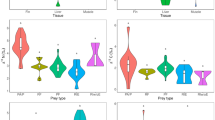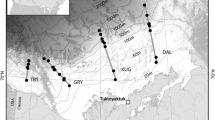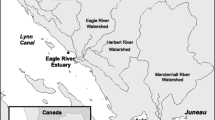Abstract
Characterizing dietary resources and species interactions in estuaries is challenging, particularly when considering the dynamic nature of these ecosystems, the ranges in body sizes of species, and the potential for trophic roles to vary with ontogeny. We examined the influence of season and location on relationships between body size and δ15N, δ13C, and δ34S values across a range of fishes from two subtropical estuaries. The results suggest that isotopic values of estuarine fishes are independent of body size. However, seasonal variation propagated throughout the assemblage as the majority of fishes integrated different δ15N, δ13C, or δ34S values. The absence of δ15N–, δ13C–, and δ34S–body size relationships suggests that either (1) dietary preference of these fishes do not shift within the range of body sizes sampled, (2) these fishes shift to an alternate diet that is not isotopically distinct, or (3) that spatial and temporal variation in isotopic signatures of prey negate any size-based relationships. Seasonal variability in the isotopic values of these fishes suggests either movement to an alternative habitat or a shift in organic matter source associated with the transition of dry to wet seasons. Moreover, variance distributions of the best-fit models indicate that seasonal dietary preferences of conspecifics do not vary over moderate spatial scales. Seasonal variability among fishes in these estuaries suggests plasticity in feeding strategies that may afford greater adaptive flexibility to these species in response to changes in food availability resulting from variable environmental conditions.


Similar content being viewed by others
References
Abrantes, K., and M. Sheaves. 2010. Importance of freshwater flow in terrestrial–aquatic energetic connectivity in intermittently connected estuaries of tropical Australia. Marine Biology 157: 2071–2086.
Akaike, H. 1973. Information theory and an extension of the maximum likelihood principle. In International symposium on information theory, 2nd ed, ed. B.N. Petran and F. Csaki, 267–281. Budapest: Akademiaiiadi.
Akin, A., and K.O. Winemiller. 2008. Body size and trophic position in a temperate estuarine food web. Acta Oecologia 33: 144–153.
Bates, D., and M. Maechler. 2010. Linear mixed-effects models using S4 class in R. University of Wisconsin, Madison. http://lme4.r-forge.r-project.org. Accessed Dec 2010.
Beck, M.W., K.L. Heck, K.W. Able, D.L. Childers, D.B. Eggleston, B.M. Gillanders, B. Halpern, C.G. Hays, K. Hoshino, T.J. Minello, R.J. Orth, P.F. Sheridan, and M.P. Weinstein. 2001. The identification, conservation and management of estuarine and marine nurseries for fish and invertebrates. Bioscience 51: 633–641.
Bligh, E.G., and W.J. Dyer. 1959. A rapid method of total lipid extraction and purification. Canadian Journal of Biochemistry and Physiology 37: 911–917.
Bouillon, S., T. Moens, I. Overmeer, N. Koedam, and F. Dehairs. 2004. Resource utilization patterns of epifauna from mangrove forests with contrasting inputs of local versus imported organic matter. Marine Ecology Progress Series 278: 77–88.
Burnham, K.P., and D.R. Anderson. 2002. Model selection and multimodel inference: A practical information—theoretic approach, 488. New York: Springer.
Chanton, J., and F.G. Lewis. 2002. Examination of coupling between primary and secondary production in a river-dominated estuary: Apalachicola Bay. Limnology and Oceanography 47: 683–697.
Cherel, Y., C. Fontaine, G.D. Jackson, C.H. Jackson, and P. Richard. 2009. Tissue, ontogenetic and sex-related differences in δ13C and δ15N values of the oceanic squid Todarodes filippovae (Cephalopoda: Ommastrephidae). Marine Biology 156: 699–708.
Connolly, R.M., M.A. Guest, A.J. Mellville, and J.M. Oakes. 2004. Sulfur stable isotopes separate producers in marine food web analysis. Oecologia 138: 161–167.
Dardeu, M.R., R.F. Modlin, W.W. Schroeder, and J.P. Stout. 1992. Estuaries. In Biodiversity of the southeastern United States: Aquatic communities, ed. C.T. Hackney, S.M. Adams, and W.M. Martin, 614–744. New York: Wiley.
Davenport, S.R., and N.J. Bax. 2002. A trophic study of a marine ecosystem off south-eastern Australia using stable isotopes of carbon and nitrogen. Canadian Journal of Fisheries and Aquatic Sciences 59: 514–530.
Deegan, L.A., and R.H. Garritt. 1997. Evidence for spatial variability in estuarine food webs. Marine Ecology Progress Series 147: 31–47.
DeNiro, M.J., and S. Epstein. 1977. Mechanism of carbon isotope fractionation associated with lipid synthesis. Science 197: 261–263.
Deudero, S., J.K. Pinnegar, N.V.C. Polunin, G. Morey, and B. Morales-Nin. 2004. Spatial variation and ontogenetic shifts in the isotopic composition of Mediterranean littoral fishes. Marine Biology 145: 971–981.
Elgee, K.E., J.P. Evans, I.W. Ramnarine, S.A. Rush, and T.E. Pitcher. 2010. Geographic variation in sperm traits reflects predation risk and natural rates of multiple paternity in the guppy. Journal of Evolutionary Biology 23: 1331–1338.
Elton, C.S. 1927. Animal ecology. London: Sidgwick and Jackson. 207 pp.
Froese, R., and D. Pauly. 2010. FishBase. www.fishbase.org. Accessed Dec 2010.
Fry, B., and C. Arnold. 1982. Rapid 13C/12C turnover during growth of brown shrimp (Penaeus aztecus). Oecologia 54: 200–204.
Galván, D.E., C.J. Sweeting, and W.D.K. Reid. 2010. Power of stable isotope techniques to detect size-based feeding in marine fishes. Marine Ecology Progress Series 407: 271–278.
Godley, B.J., D.R. Thompson, S. Waldron, and R.W. Furness. 1998. The trophic status of marine turtles as determined by stable isotope analysis. Marine Ecology Progress Series 166: 277–284.
Goering, J., V. Alexander, and N. Haubenstock. 1990. Seasonal variability of stable carbon and nitrogen isotope ratios of organisms in a North Pacific Bay. Estuarine Coastal and Shelf Science 30: 239–260.
Greenwood, N.D., C.J. Sweeting, and N.V.C. Polunin. 2010. Elucidating the trophodynamics of four coral reef fishes of the Solomon Islands using δ15N and δ13C. Coral Reefs 29: 785–792.
Griffin, M.P.A., and I. Valiela. 2001. δ15N isotope studies of life history and trophic position of Fundulus heteroclitus and Menidia menidia. Marine Ecology Progress Series 214: 299–305.
Herzka, S.Z., and G.J. Holt. 2000. Changes in isotopic composition of red drum (Sciaenops ocellatus) larvae in response to dietary shifts: Potential applications to settlement studies. Canadian Journal of Fisheries and Aquatic Sciences 57: 137–147.
Hesslein, R.H., K.A. Hallard, and P. Ramlal. 1993. Replacement of sulfur, carbon and nitrogen in tissues of growing broad whitefish (Coregonus nasus) in response to a change in diet traced by δ34S, δ13C and δ15N. Canadian Journal of Fisheries and Aquatic Sciences 50: 2071–2076.
Hoeinghaus, D.J., and S.E. Davis. 2007. Size-based trophic shifts of saltmarsh dwelling blue crabs elucidated by dual stable C and N isotope analyses. Marine Ecology Progress Series 334: 199–204.
Hurvich, C.M., and C. Tsai. 1989. Regression and time series model selection in small samples. Biometrika 76: 297–307.
Jennings, S., J.K. Pinnegar, N.V.C. Polunin, and K.J. Warr. 2002. Linking size-based and trophic analyses of benthic community structure. Marine Ecology Progress Series 226: 77–85.
Jennings, S., T.A.D. Maxwell, M. Schratzberger, and S.P. Milligan. 2008. Body-size dependent temporal variation in nitrogen stable isotope ratios in food webs. Marine Ecology Progress Series 370: 199–206.
Johnson, J.B., and K.S. Omland. 2004. Model selection in ecology and evolution. Trends in Ecology and Evolution 19: 101–108.
Kelly, M.H., and J.A. Gore. 2008. Florida river flow patterns and the Atlantic multidecadal oscillation. River Research and Applications 24: 598–616.
Kolasinski, J., P. Frouin, A. Sallon, K. Rogers, H.J. Bruggeman, and M. Potier. 2009. Feeding ecology and ontogenetic diet shift of yellowstripe goatfish Mulloidichthys flavolineatus (Mullidae) at Reunion Island, SW Indian Ocean. Marine Ecology Progress Series 386: 181–195.
Layman, C.A., K.O. Winemiller, D.A. Arrington, and D.B. Jepsen. 2005. Body size and trophic position in a diverse tropical food web. Ecology 86: 2530–2535.
Logan, J.M., and M.E. Lutcavage. 2010. Stable isotope dynamics in elasmobranch fishes. Hydrobiologia 644: 231–244.
MacAvoy, S.E., S.A. Macko, and G.C. Garman. 2001. Isotopic turnover in aquatic predators: Quantifying the exploitation of migratory prey. Canadian Journal of Fisheries and Aquatic Sciences 58: 923–932.
MacNeil, M.A., K.G. Drouillard, and A.T. Fisk. 2006. Variable uptake and elimination of stable nitrogen isotopes between tissues in fish. Canadian Journal of Fisheries and Aquatic Sciences 63: 345–353.
Minagawa, M., and E. Wada. 1984. Stepwise enrichment of 15N along food chains: Further evidence and the relation between δ15N and animal age. Geochimica et Cosmochimica Acta 48: 1135–1140.
Mittelbach, G.G., and L. Persson. 1998. The ontogeny of piscivory and its ecological consequences. Canadian Journal of Fisheries and Aquatic Sciences 55: 1454–1465.
Newsome, S.D., M.A. Etnier, D.H. Monson, and M.L. Fogel. 2009. Retrospective characterization of ontogenetic shifts in killer whale diets via δ13C and δ15N analysis of teeth. Marine Ecology Progress Series 374: 229–242.
Olin, J.A., N.E. Hussey, M. Fritts, M.R. Heupel, C.A. Simpfendorfer, G.R. Poulakis, and A.T. Fisk. 2011. Maternal meddling in neonatal sharks: Implication for interpreting stable isotopes in young animals. Rapid Communications in Mass Spectrometry 25: 1008–1016.
Peterson, B.J., and B. Fry. 1987. Stable isotopes in ecosystem studies. Annual Review: Ecology Evolution and Systematics 18: 293–320.
Peterson, B.J., and R.W. Howarth. 1987. Sulfur, carbon, and nitrogen isotopes used to trace organic matter flow in the salt-marsh estuaries of Sapelo Island, Georgia. Limnology and Oceanography 32: 1195–1213.
Platell, M.E., P.A. Orr, and I.C. Potter. 2006. Inter- and intraspecific partitioning of food resources by six large and abundant fish species in a seasonally open estuary. Journal of Fish Biology 69: 243–262.
Polis, G.A., and D.A. Strong. 1996. Food web complexity and community dynamics. The American Naturalist 147: 813–846.
Post, D.M. 2002. Using stable isotopes to estimate trophic position: Models, methods and assumptions. Ecology 83: 703–718.
Post, D.M., C.A. Layman, D.A. Arrington, G. Takimoto, J. Quattrochi, and C.G. Montaña. 2007. Getting to the fat of the matter: Models, methods and assumptions for dealing with lipids in stable isotope analyses. Oecologia 152: 179–189.
R Development Core Team. 2009. R: A language and environment for statistical computing. Vienna: R Foundation for Statistical Computing.
Raudenbush, S.W., and A.S. Bryk. 2002. Hierarchical linear models: Applications and data analysis methods. London: Sage. 491 pp.
Rountree, R.A., and K.W. Able. 1992. Fauna of polyhaline subtidal marsh creeks in southern New Jersey: Composition, abundance biomass. Estuaries 15: 171–185.
Scharf, F.S., F. Juanes, and R.A. Rountree. 2000. Predator size–prey size relationships of marine fish predators: Inter-specific variation and effects of ontogeny and body size on trophic-niche breadth. Marine Ecology Progress Series 208: 229–248.
Sheaves, M., R. Johnston, and R.M. Connolly. 2010. Temporal dynamics of fish assemblages of natural and artificial tropical estuaries. Marine Ecology Progress Series 410: 143–157.
Vander Zanden, M.J., B.J. Shuter, N.P. Lester, and J.B. Rasmussen. 2000. Within- and among-population variation in the trophic position of a pelagic predator, lake trout (Salvelinus namaycush). Canadian Journal of Fisheries and Aquatic Science 57: 725–731.
Vizzini, S., and A. Mazzola. 2003. Seasonal variations in the stable carbon and nitrogen isotope ratios (13C/12C and 15N/14N) of primary producers and consumers in a western Mediterranean coastal lagoon. Marine Biology 142: 1009–1018.
Wilson, J.P., and M. Sheaves. 2001. Short-term temporal variation in taxonomic composition and trophic structure of a tropical estuarine fish assemblage. Marine Biology 139: 787–796.
Wilson, R.M., J. Chanton, G. Lewis, and D. Nowacek. 2009. Isotopic variation (δ15N, δ13C and δ34S) with body size in post-larval estuarine consumers. Estuarine Coastal and Shelf Science 83: 307–312.
Winemiller, K.O. 1990. Spatial and temporal variation in tropical fish trophic networks. Ecological Monographs 60: 331–367.
Acknowledgments
The authors thank the staff of Mote Marine Laboratory’s Center for Shark Research and of Florida Fish and Wildlife Conservation Commission’s, Charlotte Harbor Field Laboratory, especially Michelle Heupel, Colin Simpfendorfer, Beau Yeiser, Tonya Wiley, Gregg Poulakis, Philip Stevens, and Amy Timmers for their assistance with sample collection and logistics. We are grateful to William Mark and Richard Doucette for their assistance with sulfur isotope processing and to Alice Grgicak-Mannion for her advice with ArcGIS. This research was funded through University of Windsor scholarships to J.A. Olin and Natural Sciences and Engineering Research Council (NSERC) of Canada Discovery grant funds to A.T. Fisk.
Author information
Authors and Affiliations
Corresponding author
Electronic Supplementary Material
Below is the link to the electronic supplementary material.
Table S.1
Model results for δ15N values of each fish species pooled across both estuaries (DOC 62 kb)
Table S.2
Model results for δ13C values of each fish species pooled across both estuaries (DOC 63 kb)
Table S.3
Model results for δ34S values of each fish species pooled across both estuaries (DOC 61 kb)
Rights and permissions
About this article
Cite this article
Olin, J.A., Rush, S.A., MacNeil, M.A. et al. Isotopic Ratios Reveal Mixed Seasonal Variation Among Fishes from Two Subtropical Estuarine Systems. Estuaries and Coasts 35, 811–820 (2012). https://doi.org/10.1007/s12237-011-9467-6
Received:
Revised:
Accepted:
Published:
Issue Date:
DOI: https://doi.org/10.1007/s12237-011-9467-6




